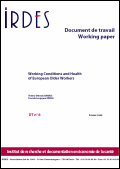|
WP n° 28
 What are the Motivations of Pathways to Retirement in Europe: Individual, Familial, Professional Situation or Social Protection Systems? What are the Motivations of Pathways to Retirement in Europe: Individual, Familial, Professional Situation or Social Protection Systems?
Debrand T., Sirven N.
Irdes working paper n° 28. 2009/10.
The aim of this research is to identify the determinants of pathways to retirement in Europe and, by measuring the influence or combined influence of individual, contextual and institutional domains on labor force participation, to better understand inter-country variations in the employment rates of older citizens. The dataset consists of both the first two longitudinal waves of SHARE (2004-2006) and some macroeconomic series from the OECD describing three complementary social protection systems (pensions, disability, employment). The analysis is simultaneously carried out in terms of “stocks” (labor force participation in 2004) and “flows” (pathways from employment in 2004 to retirement in 2006). Indicators are developed to measure the contribution of each domain (individual, contextual, institutional), and their various combinations to the employment rate of older citizens, and their role in explaining inter-country differences. As expected, results demonstrate that labor force participation and the decision to retire are determined by the various individual and contextual domains with social protection systems, each playing a significant role. Institutional determinants explain most of the intercountry differences. There appears to be a complementary effect between the different categories of social protection, and the global effect of the three systems combined is greater than the sum of the idiosyncratic effect of each system. Future public policies aiming at increasing the workforce participation of older citizens should therefore take into account that retirement decisions are determined by complex, interactive and individual determinants, and that within the European Union, the main convergence factors are to be found in the differences in social protection systems.

Published in: Retraite et Société (Cnav), n° 57, 2009/06, 35-53.
Les facteurs explicatifs du départ à la retraite en Europe.
Debrand T., Sirven N. In Emploi et retraite en Europe - Enquête SHARE. Coordonné par Attias-Donfut C. (Cnav), Sirven N. (Irdes)
Which gave rise to: Issues in Health Economics (Questions d'économie de la santé) n° 148. 2009/11.
Pathways to Retirement in Europe: Individual Determinants and the Role of Social Protection. 
Debrand T., Sirven N.
Which gave rise to: Are Health Problems Systemic? Politics of Access and Choice under Beveridge and Bismarck Systems. 
Or Z., Cases C., Lisac M., Vrangbaek K., Winblad U., Bevan G. Document de travail Irdes n° 27. 2009/09
Published in: Health Economics Policy and Law, vol 5, n° 3, 2010/07, 269-293 Are Health Problems Systemic? Politics of Access and Choice under Beveridge and Bismarck Systems.
Or Z., Cases C., Lisac M., Vrangbaek K., Winblad U., Bevan G. |

